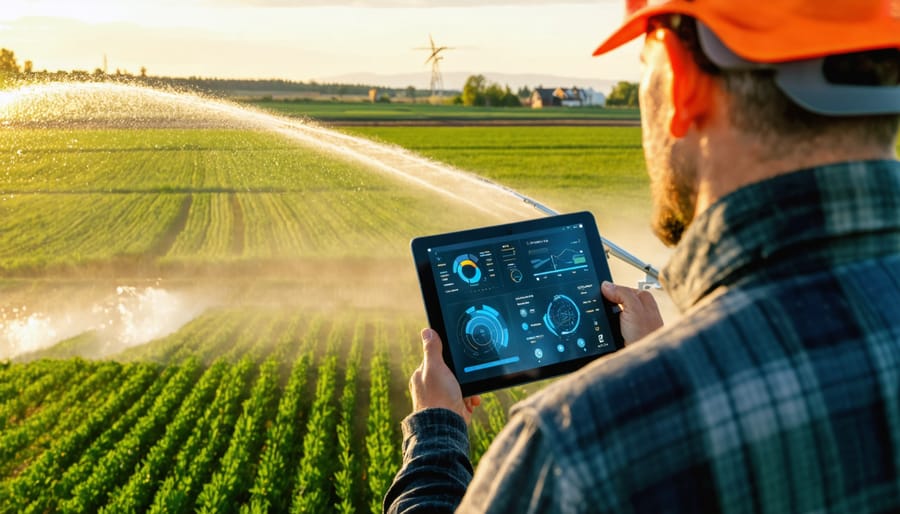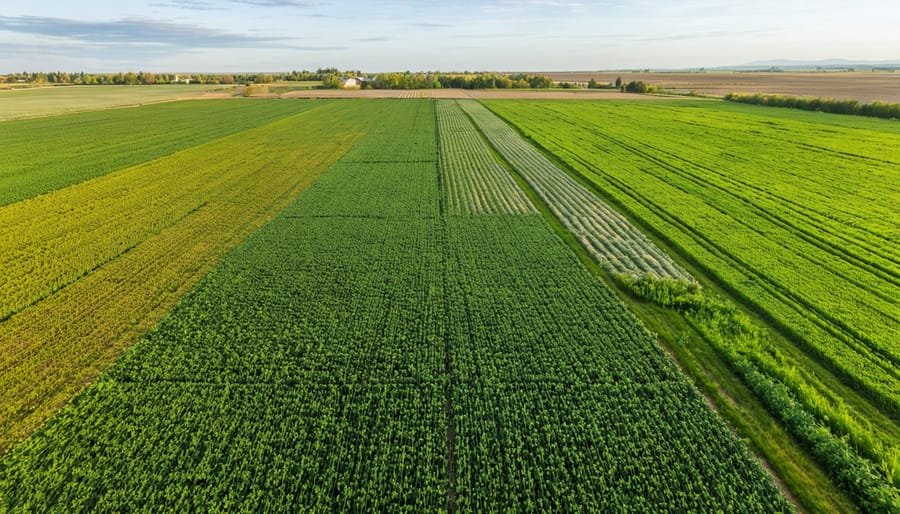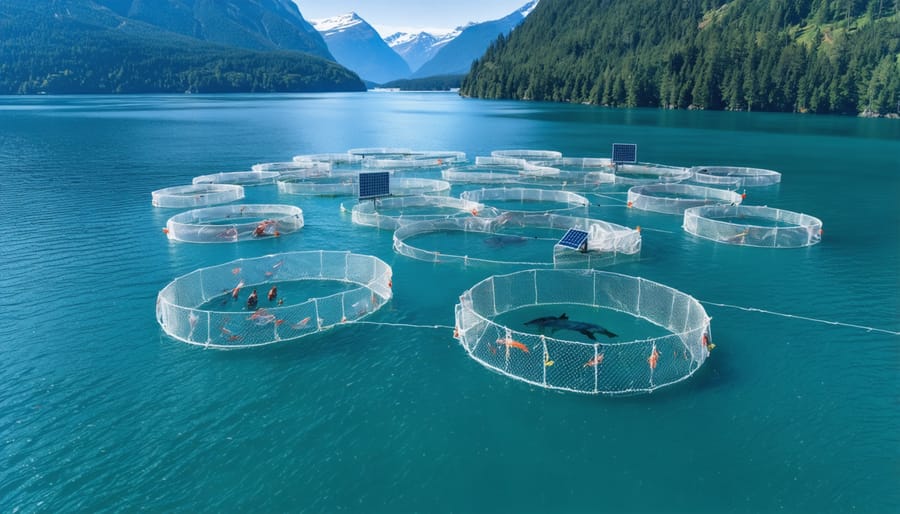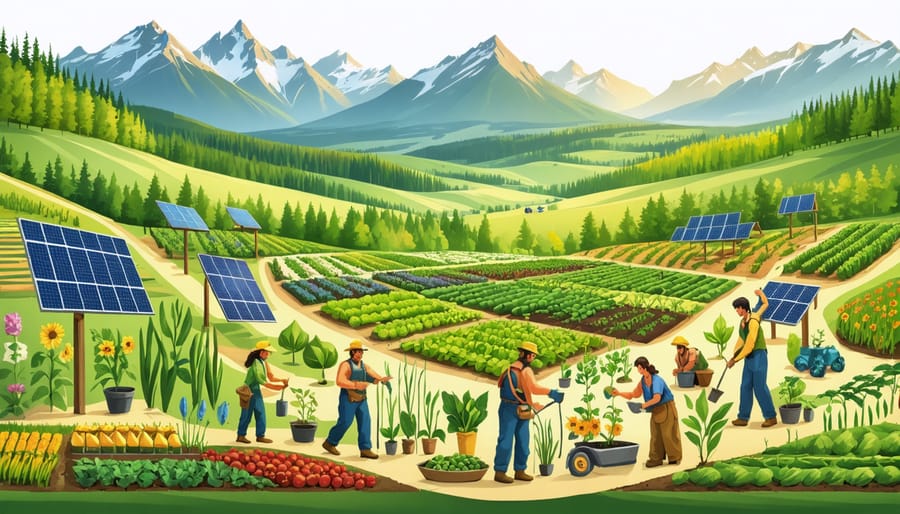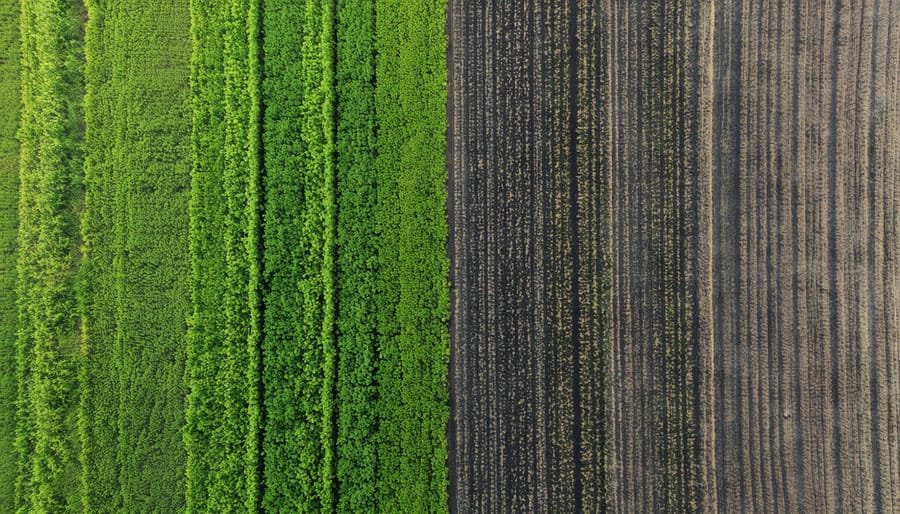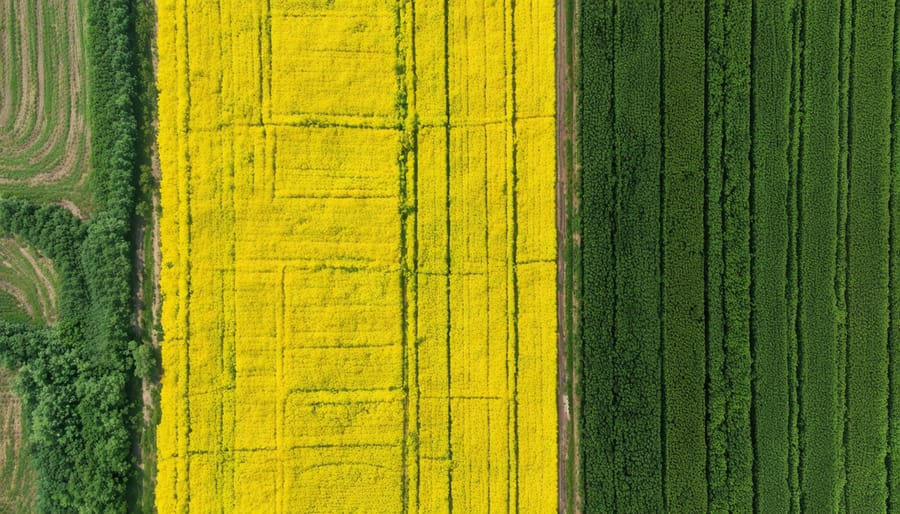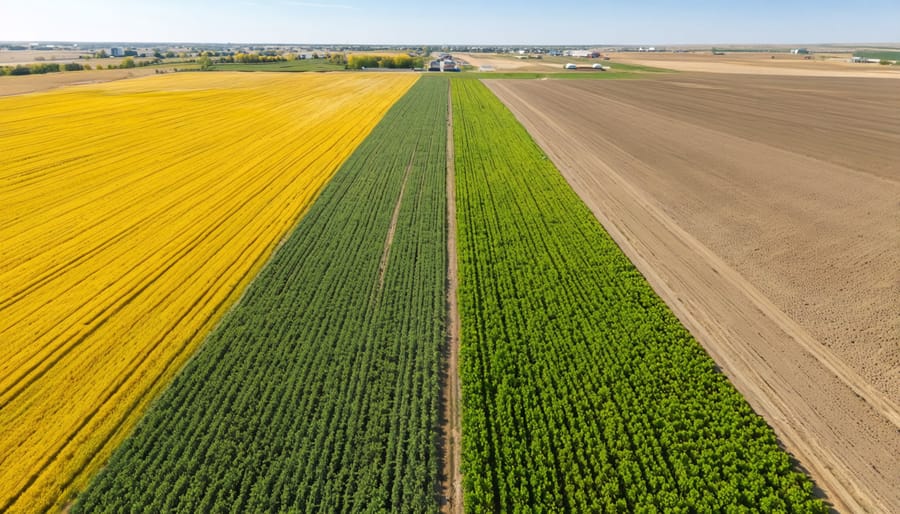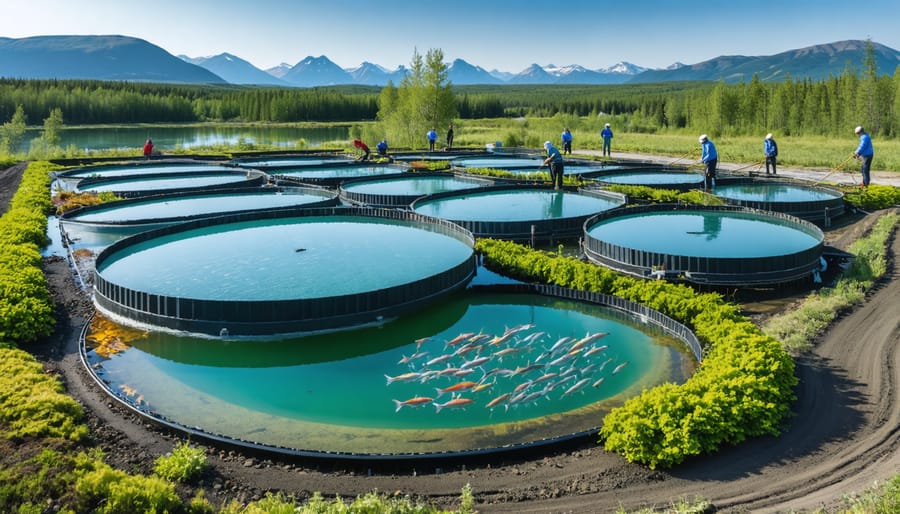Water management stands at the intersection of agricultural sustainability and economic viability for Canadian farmers. Across Alberta’s diverse growing regions, from Medicine Hat’s semi-arid conditions to the fertile Peace Country, intelligent water systems have become essential for maintaining crop yields while conserving our precious water resources. Modern water management technologies – including precision irrigation, soil moisture monitoring, and automated distribution networks – now enable farmers to reduce water usage by up to 30% while improving crop quality and yield consistency. As climate patterns continue to shift and water availability becomes increasingly unpredictable, implementing robust water management strategies isn’t just an environmental choice – it’s a crucial business decision that directly impacts farm profitability and long-term sustainability. Our agricultural sector’s future depends on adopting these innovative solutions, which combine traditional farming wisdom with cutting-edge technology to create resilient, water-efficient growing systems that work for Alberta’s unique conditions.
Modern Water Management Technologies for Canadian Farms
Precision Irrigation Systems
Modern precision irrigation systems have revolutionized water management on Canadian farms, integrating smart farming technologies to maximize efficiency while conserving our precious water resources. These systems combine soil moisture sensors, weather monitoring stations, and automated controls to deliver water exactly when and where crops need it.
In Alberta, where water management is crucial, farmers are seeing remarkable results with soil moisture sensors placed at various depths throughout their fields. These sensors provide real-time data about soil conditions, helping growers make informed decisions about irrigation timing and volume. Many producers report water savings of 20-30% while maintaining or improving crop yields.
Advanced control systems allow farmers to manage irrigation remotely through smartphone apps, adjusting watering schedules based on current conditions and weather forecasts. Variable rate irrigation technology enables different application rates across the field, accounting for soil variations and crop needs.
For example, the Thompson family farm near Lethbridge reduced their water usage by 25% after installing precision irrigation equipment. Their system includes soil probes that measure moisture at 10 cm, 30 cm, and 60 cm depths, providing comprehensive data about water movement through the soil profile.
Local irrigation specialists recommend starting with a basic soil moisture monitoring system and gradually expanding based on farm needs and budget. Many agricultural extension services offer workshops and support for farmers interested in implementing these water-smart solutions.

Water Conservation Solutions
In Alberta’s semi-arid climate, effective water conservation is crucial for sustainable farming. Modern drip irrigation systems have shown remarkable results, reducing water usage by up to 40% compared to traditional sprinkler systems while maintaining crop yields. These systems deliver water directly to plant roots, minimizing evaporation losses common in our prairie winds.
Local farmers have found success with soil moisture sensors and weather-based irrigation scheduling. These smart technologies help determine exactly when and how much to irrigate, preventing both under and over-watering. For example, the Peterson family farm near Lethbridge saved 2.5 million litres of water in one growing season by implementing these precision irrigation tools.
Mulching and conservation tillage practices have proven particularly effective in our climate. These methods help retain soil moisture and reduce evaporation rates, especially during hot summer months. Many Alberta farmers report using crop residue as natural mulch, which not only conserves water but also improves soil health.
Water recycling systems are gaining traction across the province. Collected rainwater and treated greywater can supplement irrigation needs, particularly during dry spells. The installation of retention ponds has become a popular solution, with some operations capturing up to 75% of their annual irrigation needs through stored rainfall.
Remember to consider Alberta’s unique weather patterns when selecting conservation methods. What works well in southern regions may need adjustment for central or northern operations.
Integrating Water Management with Sustainable Practices
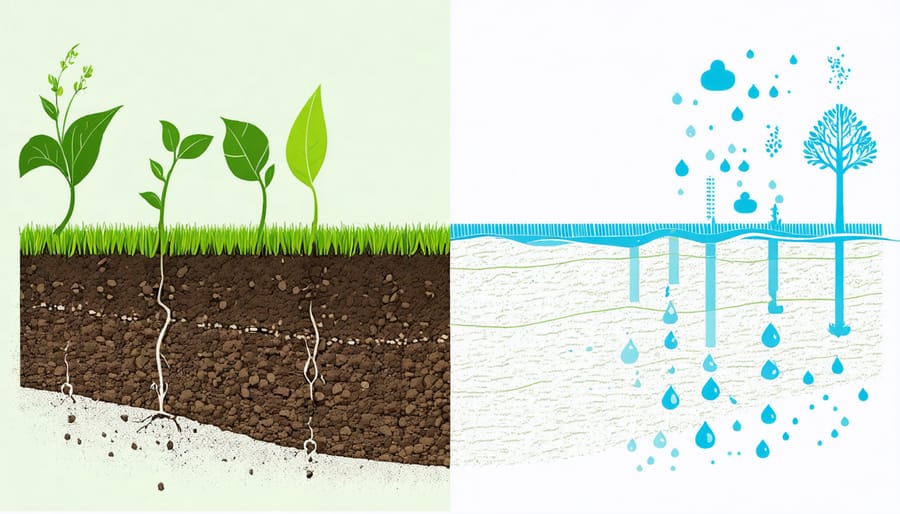
Soil Health and Water Retention
The foundation of effective water management lies in healthy soil management practices that enhance water retention and promote sustainable agriculture. Here in Alberta, where moisture conservation is crucial, understanding soil health is key to maximizing every drop of water.
Well-structured soil acts like a sponge, holding water and nutrients while maintaining proper aeration. By increasing organic matter content through practices like cover cropping and crop rotation, farmers can improve their soil’s water-holding capacity by up to 20%. For every 1% increase in organic matter, soil can retain an additional 25,000 litres of water per hectare.
Many Alberta farmers have found success with reduced tillage practices, which help maintain soil structure and prevent moisture loss through evaporation. Adding organic amendments, such as compost or manure, further enhances soil biology and water retention capabilities. These practices also improve soil aggregation, creating pathways for water infiltration and root growth.
Monitoring soil moisture levels through tools like soil moisture probes helps farmers make informed decisions about irrigation timing and volume. Regular soil testing provides valuable insights into organic matter content and soil structure, allowing for targeted improvements where needed.
The benefits extend beyond water conservation. Healthy soils reduce runoff, minimize erosion, and support beneficial microorganisms that contribute to crop health. This integrated approach to soil and water management has helped many local farmers reduce irrigation needs while maintaining or improving crop yields, demonstrating that good soil stewardship is fundamental to water-efficient farming systems.
Carbon Footprint Reduction
Implementing efficient water management systems plays a crucial role in reducing your farm’s carbon footprint while maintaining productivity. Here in Alberta, where energy costs can significantly impact operational expenses, smart water management offers a practical path to both environmental and economic sustainability.
Consider this: Every litre of water pumped, treated, or heated requires energy. By optimizing your water usage, you’re not just conserving water – you’re directly reducing energy consumption and associated greenhouse gas emissions. Local data shows that farms implementing precision irrigation systems typically see a 20-30% reduction in energy use compared to conventional methods.
Sarah Thompson, a third-generation farmer near Lethbridge, shares her experience: “After installing soil moisture sensors and upgrading to a variable-rate irrigation system, we cut our pumping costs by 25% in the first season. That’s both money saved and emissions reduced.”
Key carbon-reducing strategies include:
– Using gravity-fed systems where possible
– Implementing automated irrigation scheduling
– Maintaining equipment for optimal efficiency
– Installing renewable energy sources for pumping systems
– Choosing drought-resistant crops that require less irrigation
The Alberta Agricultural Carbon Offset System recognizes these efforts, allowing farmers to earn carbon credits through verified water efficiency improvements. Many producers are finding that these initiatives align perfectly with both environmental stewardship and business sustainability.
Remember, every drop saved means less energy used for pumping and distribution. By adopting water-efficient practices, you’re not just protecting our water resources – you’re actively contributing to Canada’s climate change mitigation efforts while strengthening your farm’s resilience for future generations.
Real Alberta Success Stories
Small-Scale Implementation
The Henderson family farm in Lacombe County, Alberta, presents a compelling example of successful small-scale water management implementation. In 2019, Mike and Sarah Henderson transformed their 160-hectare mixed crop operation by introducing an integrated water management system that has since become a model for neighbouring farms.
The Hendersons started by installing a precision irrigation system, combining soil moisture sensors with weather monitoring equipment. This allowed them to reduce water usage by 30% while maintaining crop yields. They also implemented a series of retention ponds strategically placed to capture spring runoff and summer rainfall, providing a reliable water source during dry periods.
A key component of their success was the installation of subsurface drip irrigation in their high-value crop areas, which decreased water loss through evaporation and improved nutrient delivery to plant roots. The family also incorporated drought-resistant crop varieties and adopted conservation tillage practices to enhance soil moisture retention.
The total investment of $75,000 was partially offset by provincial agricultural grants, and the system paid for itself within three years through reduced water costs and improved crop yields. The Hendersons now host regular farm tours, sharing their experience with other local farmers and demonstrating how small-scale operations can implement effective water management solutions.
“The system has completely changed how we think about water on our farm,” says Sarah Henderson. “We’re not just saving water; we’re farming more efficiently and sustainably.”
Large Operations Excellence
The Bow River Valley Farm in southern Alberta stands as a prime example of large-scale water management excellence. Operating across 2,000 hectares of mixed-crop farmland, the operation has revolutionized its water usage through innovative systems implementation over the past five years.
Farm manager Sarah Thompson explains, “We’ve reduced our water consumption by 40% while increasing crop yields by implementing precision irrigation technology and soil moisture monitoring.” The farm uses a network of soil sensors placed strategically throughout the fields, providing real-time data on moisture levels and helping inform irrigation decisions.
A key feature of their system is the integration of weather forecasting data with automated irrigation controls. This allows for proactive adjustments to watering schedules based on predicted rainfall and evaporation rates. The farm has also installed retention ponds that capture spring runoff and summer rainfall, storing it for use during drier periods.
The results speak for themselves: annual water savings of approximately 500 million litres, improved crop consistency, and reduced operational costs. The farm has also noticed enhanced soil health and decreased erosion since implementing these changes.
“What’s particularly exciting,” Thompson adds, “is how we’ve been able to share our learnings with neighbouring farms. We’ve hosted several field days where other farmers can see our systems in action and learn from our experiences.”
Getting Started with Better Water Management
Assessment and Planning
Before implementing any water management system, it’s crucial to thoroughly assess your current water usage patterns and develop a comprehensive plan. Start by conducting a detailed water audit of your farm operation, measuring water consumption across different activities like irrigation, livestock needs, and processing.
Record keeping is essential – track your water usage throughout the seasons, noting peak demand periods and identifying potential inefficiencies. Many Alberta farmers find success using digital monitoring systems that provide real-time data on water consumption and distribution patterns.
Consider working with local agricultural extension services to evaluate your soil composition and water retention capabilities. Understanding your soil’s characteristics helps determine the most effective irrigation methods and timing for your specific situation.
When planning improvements, set realistic goals based on your findings. Prioritize upgrades that offer the best return on investment – both environmentally and financially. For example, many farmers in southern Alberta have found that switching to drip irrigation systems reduced their water usage by 30-40% while maintaining or improving crop yields.
Create a timeline for implementing changes, keeping in mind seasonal demands and budget constraints. Include regular maintenance checks and performance reviews in your plan to ensure long-term success. Remember to factor in potential climate variations and have contingency plans for drought conditions, which are becoming more common in our region.

Available Resources and Support
Alberta farmers have access to numerous resources and support systems to help implement effective water management strategies. The Alberta Irrigation Technology Centre offers free consultations and workshops throughout the growing season, providing hands-on training in modern irrigation techniques and system maintenance.
Financial assistance is available through the Canadian Agricultural Partnership (CAP), which provides grants covering up to 50% of costs for water management improvements. The Environmental Farm Plan program offers additional funding opportunities and technical support for sustainable water practices.
Local agricultural extension offices maintain networks of water management specialists who provide on-site assessments and customized recommendations. The Alberta Federation of Agriculture connects farmers with mentorship opportunities, allowing experienced producers to share their water management expertise with others in the community.
Several research institutions, including Olds College and the University of Alberta, offer testing services for water quality and soil moisture analysis. Their agriculture departments regularly conduct field demonstrations and publish practical guides specific to Alberta’s climate conditions.
For immediate support, the Alberta Agriculture Information Centre provides a toll-free helpline staffed by qualified agricultural experts. They can answer questions about water management systems and direct farmers to relevant local resources. The Centre also maintains an online database of technical documents, case studies, and best practices guides specifically developed for Alberta’s agricultural conditions.
Effective water management is no longer optional for Canadian farmers – it’s essential for our agricultural future. By implementing smart irrigation systems, exploring water conservation techniques, and adopting sustainable practices, we can significantly improve both crop yields and environmental stewardship. The success stories from fellow Alberta farmers demonstrate that these systems are not just theoretical solutions but practical, profitable investments. Taking the first step toward better water management might seem daunting, but remember that local agricultural extension offices and farming communities are here to help. Start small, perhaps with soil moisture monitoring or basic irrigation scheduling, and gradually build your system. Together, we can ensure our farms remain productive and sustainable for generations to come. Reach out to your local agricultural advisor today to begin your water management journey.

